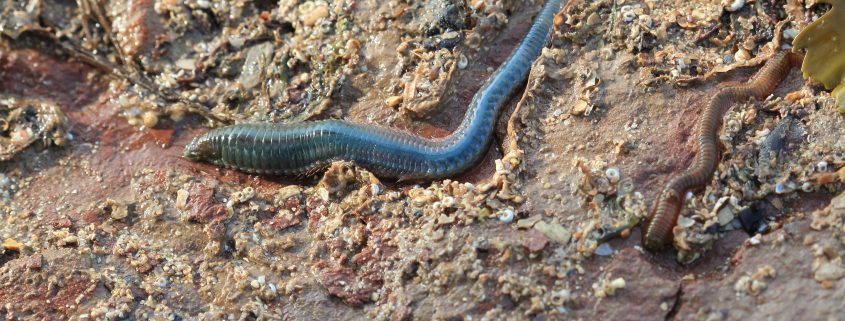Bait worms: a valuable and important fishery with implications for fisheries and conservation management
By Brenna Bales, SRC intern
Historically, bait fisheries around the world have been perceived as low-value, and their often limited, local extent makes large-scale management and conservation policy difficult to implement. Watson et. al 2016 explored three ragworm fisheries in the United Kingdom to investigate these claims, based on both evidence gathered scientifically and from an analysis of published literature. The data on polychaete bait fisheries is extremely limited, causing inaccurate estimates of catch amounts and collection efforts. In order to accurately assess the three bait fisheries of focus and other fisheries worldwide, Watson and other researchers assessed the following: retail value of bait species collected, extent of collection efforts both geographically and quantitatively, bait storage methods, and the choice and amount of bait used by angler fisherman on an average fishing trip.
The five most expensive (£/kg) species of marine animals sold on the global fish market are polychaetes (Glycera dibranciata, Diopatra aciculata, Nereis (Alitta) virens, Arenicola defodiens, and Marphysa sanguinea). The values of these bait species were quantified using retail prices of the species online and from data gathered from other literature sources. It was concluded that N. virens landings alone in the UK annually are worth approximately £52 million. Globally, this number is around £5.8 billion, with 121,000 tonnes of N. virens being landed worldwide. This demonstrates the high value of polychaete bait, contrary to popular opinion.

Nereis (Alitta) virens, commonly known as a sand worm, are a popular polychaete worm collected for bait purposes in UK tidal fisheries. (source: https://commons.wikimedia.org/wiki/File%3ANereis_virens_und_Nereis_diversicolor.jpg)
The three UK sites surveyed were Fareham Creek, Portsmouth Harbour; Dell Quay, Chichester Harbour; and Pagham Harbour. They were monitored over a period from August to September 2011, using remote closed circuit television recordings. The time for each digger on-site was recorded, and based on the number of times they placed a worm in their collection bucket, the biomass (mass of live worms) collected was estimated. The mean removal rate per bait collector per hour was 228 ± 64 worms. This large amount of collection can lead to things like environmental disturbance (trampling), over-exploitation of collection species, and the depletion of food resources for bird species that consume these worms.

This Japanese coastal bird feeds off a small ragworm, species that are globally collected as bait. When too many worms are removed by collectors, it can have serious consequences for the animals that rely on them for food. (source: https://commons.wikimedia.org/wiki/File%3ACharadrius_mongolus_stegmanni_eating_ragworm.JPG)
An investigation as to how long certain species could be kept fresh before being used as bait on fishing trips was also conducted. The amount of time that N. virens could be maintained as viable bait was at the least 2 weeks. Given the average amount of N. virens used on angling trips per week was 0.33 kilograms, that amount of bait could be collected in only 28 minutes during a tidal cycle, based on the mean removal rate per bait collector per hour.
In conclusion, Watson et. al. proved that there needs to be a re-examination of the importance of polychaete bait fisheries worldwide, in order for better conservation initiatives to be launched. Seeing as the majority of these bait fisheries are located in MPAs (marine protected areas), better regulations must be enforced. There are several proposals in the study, such as personal catch limits, surveillance conservation, and stakeholder involvement. Overall, these fisheries are worth a lot more than is currently thought, and the implications of continuing poor management could have serious consequences.
Works Cited
Watson, Gordon J., et al. “Bait worms: a valuable and important fishery with implications for fisheries and conservation management.” Fish and Fisheries (2016).




Leave a Reply
Want to join the discussion?Feel free to contribute!